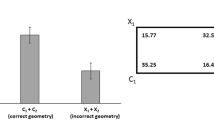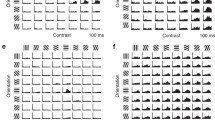Summary
-
1.
The role of the different senses in the orientation of shrews has been analysed.
-
2.
The orientation of shrews is chiefly determined by tactile sensations and spatial memory. Tactile sensation is especially important in short-distance orientation.
-
3.
Vision plays a subordinate role in orientation. Distinction of light and dark and directional vision were shown to be used in orientation. No indication was found for a participation of form-vision in orientation.
-
4.
Olfaction is well developed and plays an important role in the search for food. Scent-marking of objects gives them familiar characters, a shrew however does not follow his own scent trails.
-
5.
Audition is highly developed, but echolocation does not exist.
-
6.
Shrews rapidly acquire an exact knowledge of their environment. Spatial memory then controlls orientation to such a degree, that direct sensorial perception has only subsidiary functions. Spatial memory is so fixed, that environmental changes cannot immediately alter it.
Zusammenfassung
-
1.
Das Orientierungssystem der Spitzmäuse wurde eingehend nach Art und Leistung der beteiligten Sinne analysiert.
-
2.
Die Orientierung der Spitzmäuse wird hauptsächlich vom Tastsinn und vom räumlichen Erinnerungsvermögen bestimmt. Der Tastsinn hat eine hervorragende Bedeutung bei der Nahorientierung.
-
3.
Der Gesichtssinn spielt eine untergeordnete Rolle. Helligkeitsunterscheidung und Richtungssehen lassen sich als orientierende Komponenten nachweisen. Für die Beteiligung eines Bildsehens bei der Orientierung ergaben sich keine Hinweise.
-
4.
Das Geruchsvermögen ist gut entwickelt. Es spielt eine wichtige Rolle bei der Nahrungssuche. Eigenduftspuren verleihen Gegenständen Vertrautheitscharakter, zum Wegfinden werden sie nicht benutzt.
-
5.
Das Gehör ist empfindlich ausgebildet. Eine Schallortung ist nicht nachzuweisen.
-
6.
Spitzmäuse erwerben schnell eine genaue Raumkenntnis. Diese bestimmt die Orientierung derart, daß unmittelbare Sinneswahrnehmung zurücktritt. Das Raumbild ist so fixiert, daß Veränderungen der Umgebung es nur langsam umformen.
Similar content being viewed by others
Literatur
Brotzler, A.: Untersuchungen zum Orientierungsverhalten des syrischen Goldhamsters (Mesocricetus auratus Waterhouse). Z. vergl. Physiol. 47, 148–190 (1963).
Buttler, G.: Ein Beitrag zur Sexualbiologie der Insektivoren unter besonderer Berücksichtigung der accessorischen Drüsen der Soriciden Crocidura leucodon Herm. und C. russula Herm. Diss. Braunschweig 1953.
Crowcroft, P.: Notes on the behaviour of shrews. Behaviour 8, 63–80 (1955).
—: The life of the shrew. London: Max Reinhardt 1957.
Godet, R.: Contribution à l'éthologie de la Taupe (Talpa europaea L.). Bull. Soc. zool. France 76, 107–128 (1951a).
Gould, E.: Evidence for echolocation in shrews. Ph.D. thesis, Tulane University 1962.
—: Evidence for echolocation in the Tenrecidae of Madagasca. Proc. Amer. phil. Soc. 109, 352–360 (1965).
—, N. Negus, and A. Novick: Evidence for echolocation in shrews. J. exp. Zool. 156, 19–38 (1964).
Griffin, D. R.: Listening in the dark. New Haven, Connecticut: Yale University Press 1958.
Henson, O'Dell W., Jr.: Some morphological and functional aspects of certain structures of the middle ear in bats and Insectivores. Univ. Kansas Sci. Bull. 62, 3, 151–255 (1961).
Herter, K.: Der Temperatursinn der Säugetiere. Beitr. Tierkunde Tierzucht 3, 1–171 (1952).
—: Das Verhalten der Insektivoren. Handbuch der Zoologie, Bd. 8, S. 1–50. Berlin: de Gruyter 1957.
Holling, C. S.: Sensory stimuli involved in the location and selection of sawfly cocoons by small mammals. Canad. J. Zool. 36, 633–653 (1958).
Hoogstraal, H.: A brief review of the contemporary land mammals of Egypt (including Sinai). 1. Insectivora and Chiroptera. J. Egypt. publ. Hlth. Ass. 37, No 4 (1962).
Johnsen, S.: Über die Seitendrüsen der Soriciden. Anat. Anz. 46, 139–149 (1914).
Kahmann, H., u. K. Ostermann: Wahrnehmen und Hervorbringen hoher Töne bei kleinen Säugetieren. Experientia (Basel) 7, 268 (1951).
Kriszat, G.: Untersuchungen zur Sinnesphysiologie, Biologie und Umwelt des Maulwurfs. Z. Morph. Ökol. Tiere 36, 446–511 (1940).
—: Die Orientierung im Raum bei Talpa europaea. Z. Morph. Ökol. Tiere 36, 512–556 (1940).
Kühl, W., G. R. Schodder, and F. K. Schröder: Condenser transmitter and microphones with solid dielectric for airborne ultrasonics. Acustica 4, 519–532 (1954).
Kulzer, E.: Physiologische und morphologische Untersuchungen über die Erzeugung der Orientierungslaute von Flughunden der Gattung Rousettus. Z. vergl. Physiol. 43, 231–268 (1960).
Le Gros Clark, W.: The brain of the Insectivora. Proc. zool. Soc. Lond. II, 102, 975–1013 (1932).
Lindauer, M.: Allgemeine Sinnesphysiologie. Orientierung im Raum. Fortschr. Zoologie 16, 58–140 (1964).
Lindemann, W.: Zur Psychologie des Igels. Z. Tierpsychol. 8, 224–251 (1951).
Löhrl, H.: Studien an einheimischen Muriden und Soriciden. Z. Säugetierk. 13, 114–160 (1938/39).
Möhres, F. P.: Über die Ultraschallorientierung der Hufeisennasen (Chiroptera-Rhinolophinae). Z. vergl. Physiol. 34, 547–588 (1953).
—, u. G. Neuweiler: Leistungen des Raumgedächtnisses bei Megaderma lyra. Z. vergl. Physiol. 53, 195–227 (1966).
-, u. T. H. zu Oettingen-Spielberg: Versuche über die Nahorientierung und das Heimfindevermögen der Fledermäuse. Verh. Dtsch. Zool. Ges. Mainz 1949, S. 248–252.
Neuhaus, W.: Versuche über die Richtungsorientierung mit normalen und blinden Mäusen. Z. Tierpsychol. 7, 380–402 (1950).
Niethammer, G.: Zur Jungenpflege und Orientierung der Hausspitzmaus (Crocidura russula Herm.). Bonner zool. Beitr. 1, 117–125 (1950).
Pearson, O. P.: Scent glands of the short-tailed shrew. Anat. Rec. 94, 615–629 (1946).
Platzer, W.: Zur vergleichenden Anatomie der Cochlea bei Talpa europaea und Sorex. Anat. Anz. 115, 113–118 (1964).
Riley, D. A., and M. R. Rosenzweig: Echolocation in rats. J. comp. physiol. Psychol. 50, 323–328 (1957).
Seitz, E.: Die Bedeutung geruchlicher Orientierung beim Plumplori Nycticebus coucang Boddaert, 1785 (Prosimii, Lorisidae). Z. Tierpsychol. 26, 73–103 (1969).
Sharma, D. R.: Studies of the anatomy of the Indian Insectivore Suncus murinus. J. Morph. 102, 427–535 (1958).
Vogelberg, L., u. F. Krüger: Versuche über die Richtungsorientierang bei weißen Mäusen und Ratten. Z. Tierpsychol. 8, 293–321 (1951).
Wahlström, A.: Beiträge zur Biologie von Crocidura leucodon (Feldspitzmaus). Z. Säugetierk. 4, 157–185 (1929).
Zippelius, H., u. W. M. Schleidt: Ultraschall-Laute bei jungen Mäusen. Naturwissenschaften 21, 502 (1956).
Author information
Authors and Affiliations
Rights and permissions
About this article
Cite this article
Grünwald, A. Untersuchungen zur Orientierung der Weißzahnspitzmäuse (Soricidae — Crocidurinae). Z. Vergl. Physiol. 65, 191–217 (1969). https://doi.org/10.1007/BF00297683
Received:
Issue Date:
DOI: https://doi.org/10.1007/BF00297683




